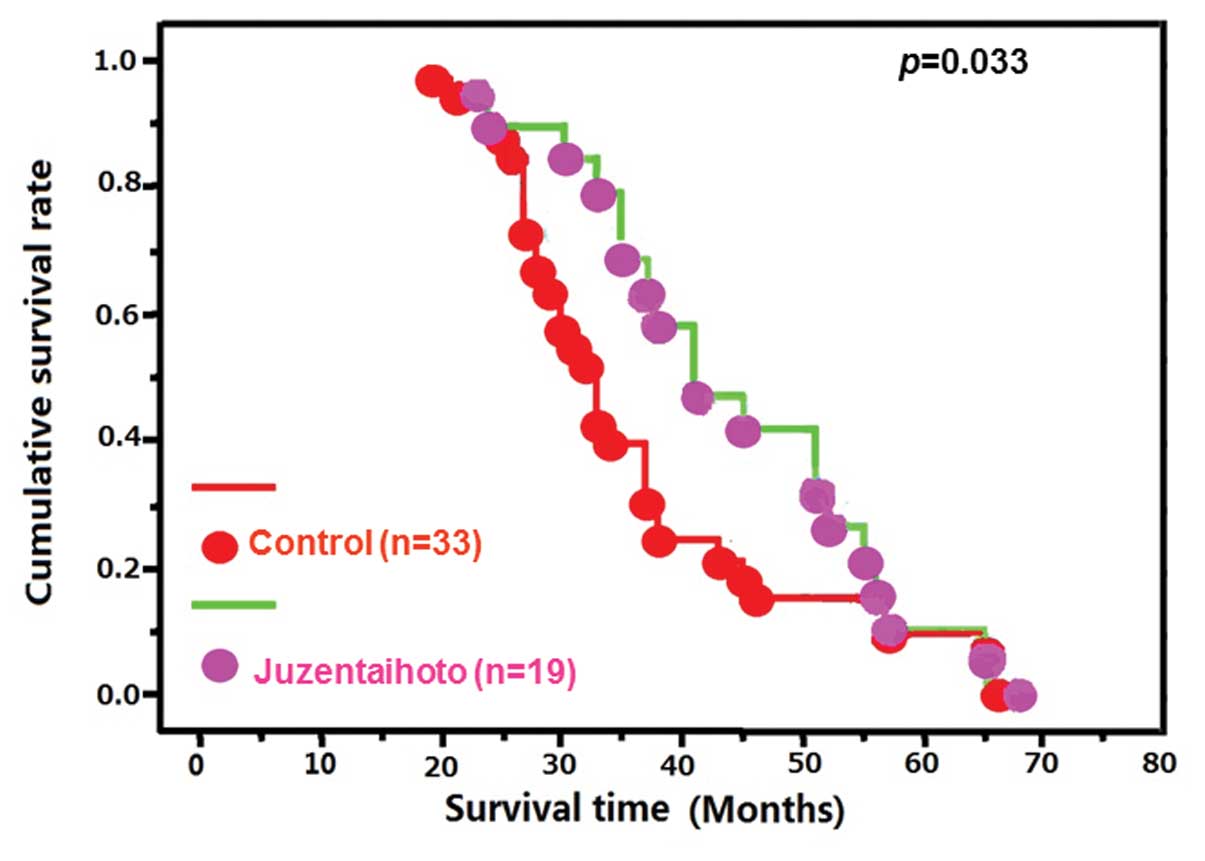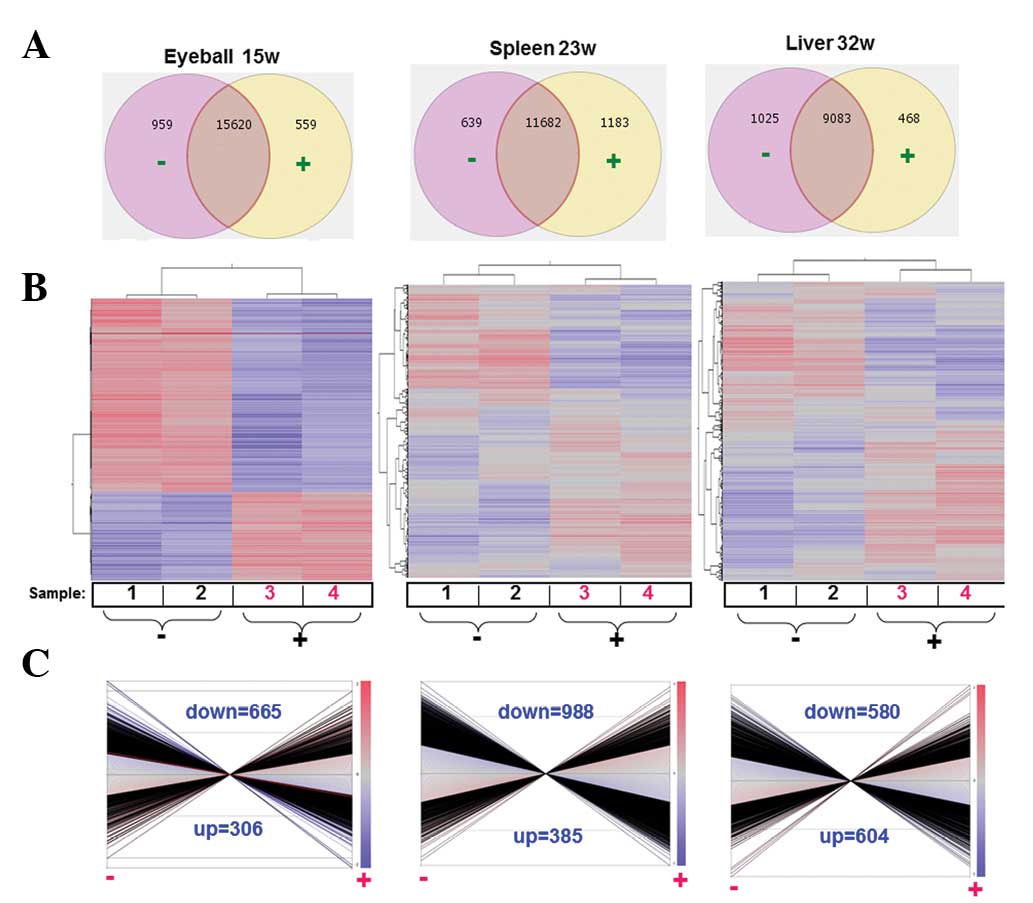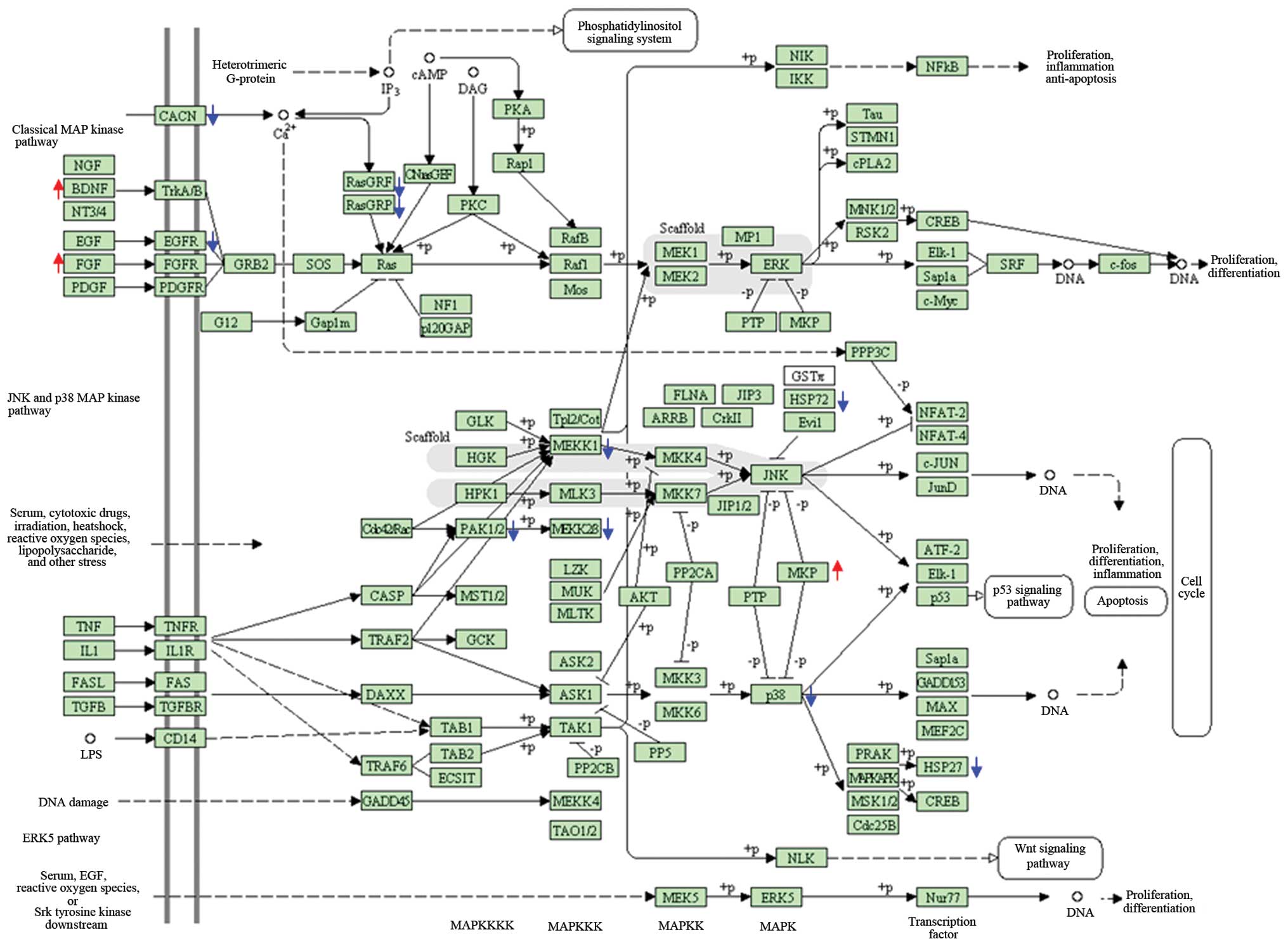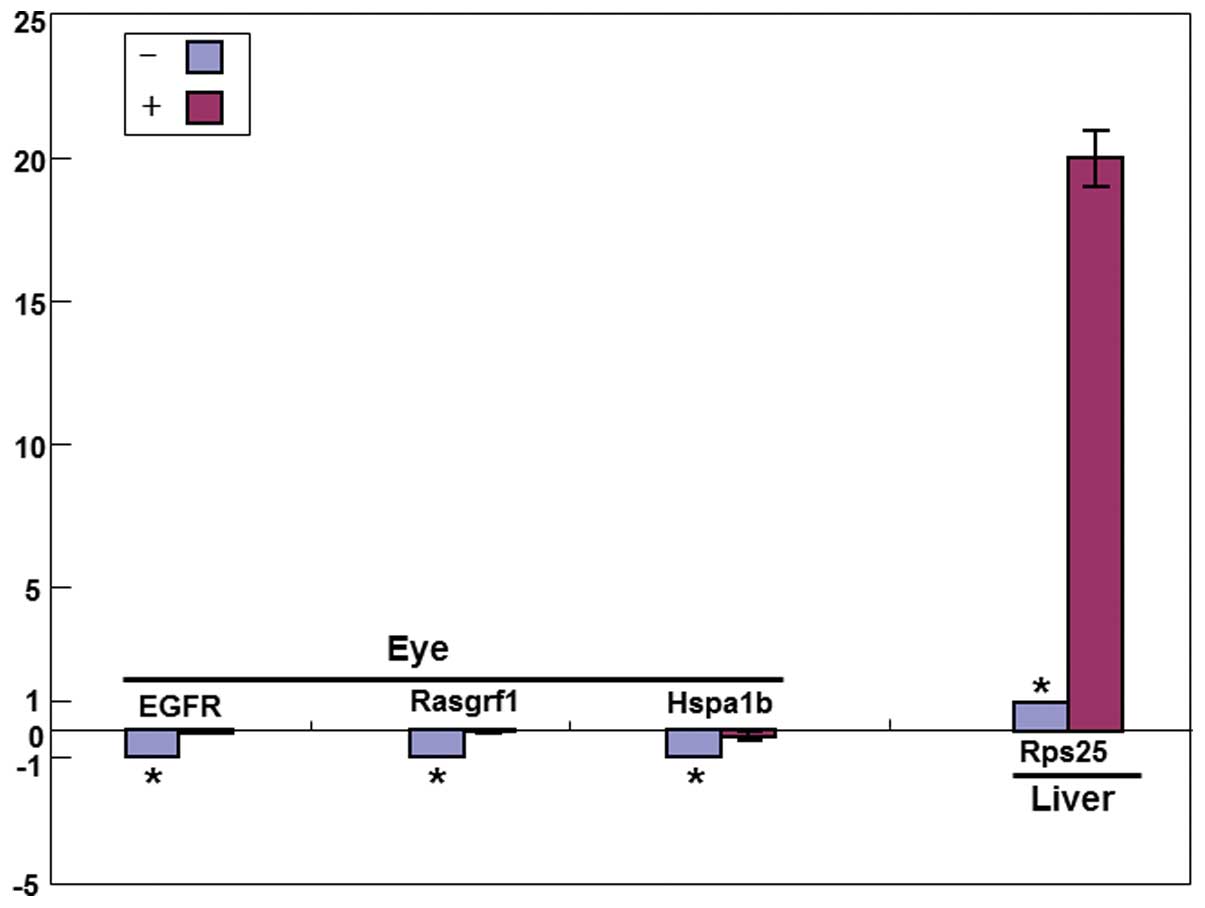Gene expression profiling of lens tumors, liver and spleen in α-crystallin/SV40 T antigen transgenic mice treated with Juzen-taiho-to
- Authors:
- Published online on: December 10, 2013 https://doi.org/10.3892/mmr.2013.1854
- Pages: 547-552
Abstract
Introduction
Simian vacuolating virus 40 (SV40) is a member of the polyomavirus family, which also includes the JC and BK viruses. SV40 has icosahedral capsids and contains small, circular, double-stranded DNA genomes. The early region is alternatively spliced to produce the small t antigen and the large T antigen, a large phosphoprotein that has a p53-binding domain and consequently provides essential functions to promote cellular proliferation and viral replication, in particular the rhesus monkey. Data on the nature of SV40 infection in humans are available (1,2,3). When administered in high doses, oncogenic SV40 is capable of transforming rodent and human cells in culture (3,4). The high rates of recovery of SV40 DNA sequences from cancer tissues have indicated that SV40 infection may be important in the development of mesothelioma, brain tumors, bone tumors, osteosarcoma, non-Hodgkin’s lymphoma, choroid plexus tumors and ependymomas (5). The process of cellular transformation induced by SV40 typically depends on the integration of the viral DNA into the host genome and a high level of expression of the major viral oncogenic proteins, large T antigen and small t antigen. The large T antigen is a multifunctional protein with a DnaJ domain, a retinoblastoma protein (Rb)-binding domain and a p53-binding domain, that are involved in a wide range of cellular processes, including transcriptional activation and repression, the inhibition of differentiation, the stimulation of the cell cycle, repression of apoptosis and cell transformation. In particular, it can bind to and perturb p53, Rb, p107, p130, CBP/p300 and RASSF1A, causing unregulated cell growth and cellular immortalization (2,6,7).
As transcription of the α-crystallin gene occurs exclusively in the lens, we established the lens tumor model of αT3 transgenic mice using the lens-specific α-crystallin A promoter and the oncogenic SV40 T antigen gene. In the mouse lens, there appeared, sequentially, dysplasia (2 weeks pre-birth), then carcinoma in situ (2 months post-birth), followed by invasion inside the eyeball (4 months) and outside the eyeball (8 months), and final metastasis into the lymph node or lung (12 months). Gene chip analysis indicated that numerous aspects of cell function markedly changed, including the cell cycle, cell morphology, cell development and cell-to-cell signaling due to lens carcinogenesis. Analyses of the top canonical pathways indicated significant differences regarding the metabolism of carbohydrates, amino acids, nucleotides, xenobiotics and nitrogen. Cluster analysis demonstrated a marked distinction in cell proliferation and cell death following invasion of the carcinoma. There were significant alterations in cell growth, the cell cycle, cell-to-cell signaling and metabolism once carcinoma metastasis had occurred (8).
The autogenic lens tumor model provides a tool to screen anti-tumor reagents in vivo. Juzen-taiho-to, a Chinese medicine that combines 10 herbs, is employed as a nutritional agent to improve disturbances and imbalances in the homeostasis of the body. It is used to help alleviate general symptoms, including extreme fatigue, a pale complexion, loss of appetite, dry or scaly skin, night sweating and dryness of the mouth in postsurgical patients, and in patients with chronic illnesses (9). Additionally, it has been demonstrated to suppress tumors by enhancing phagocytosis, cytokine induction and antibody production, and inducing the mitogenic activity of spleen cells. In the present study, we administered Juzen-taiho-to orally to SV40 T antigen transgenic mice initiated by the α-crystallin promoter in order to investigate its anti-tumor effects and the underlying mechanisms using gene chip analysis.
Materials and methods
Animals
αT3 transgenic mice with α-crystallin/SV40 T antigen generated on the background of wild-type FVB were produced and maintained by our group (8). The mice were housed in plastic cages with paper chips for bedding, three mice per house, in pathogen-free conditions in a temperature-controlled animal room with a 12 h light/dark illumination cycle. All had access to standard rodent food (CE-2; CLEA Japan, Tokyo, Japan) and water ad libitum. Juzen-taiho-to (Tsumura, Tokyo, Japan; 1.5%) containing 10 herbs (Astragalus membranaceus, 10.5%; ginseng, 10.5%; cassia, 10.5%; angelica, 10.5%; rhizoma ligustici wallichii, 10.5%; peony, 10.5%; prepared rhizome of rehmannia, 10.5%; Atractylodes macrocephala, 10.5%; Tuckahoe, 10.5%; liquorice, 5.5%) was mixed into the food at the rate of 15% from 4 weeks following birth (1200–1800 mg/kg/day). Animal use procedures were in accordance with the Guide for the Care and Use of Laboratory Animals and approved by the Committee on Animal Experimentation of Liaoning Medical University (Jinzhou, Liaoning, China), Kanagawa Cancer Center (Yokohama, Kanagawa, Japan) and Kawasaki Medical School (Kurasiki, Okayama, Japan).
Samples
After the animals were sacrificed under sodium pentobarbital anesthesia, eyeballs, spleens and livers were dissected at 15, 23 and 32 weeks following the oral administration of Juzen-taiho-to, respectively. The samples of eyeball, spleen and liver were immediately frozen in liquid nitrogen and then stored at −80°C until use. Total RNA was extracted from frozen tissues using TRIzol reagent (Invitrogen Life Technologies, Carlsbad, CA, USA) according to the manufacturer’s instructions. The quality of the RNA was assessed by running aliquots on denatured agarose gels.
Affymetrix GeneChip hybridization
For the investigation of gene expression, the MM8-60mer-exp-X 4 array (NimbleGen, Madison, WI, USA) was applied, which represents over 24,000 transcripts. Sample preparation was performed according to the manufacturer’s instructions. Briefly, 10 μg of total RNA was used to synthesize double-stranded complementary DNA with a GeneChip® Expression 3′-Amplification Reagents One-Cycle cDNA Synthesis kit (Affymetrix, Santa Clara, CA, USA). cDNA labeled with Cy3 using a labeling kit (NimbleGen) was hybridized to a GeneChip array at 42°C for 16 h. The chip was washed and scanned with GenePix Personal 4100A (NimbleGen) and the results were analyzed using the Subio Platform (Affymetrix). Hybridization intensity data were converted into presence/absence calls for each gene and changes in gene expression between the experiments were detected by comparison analysis. A difference of two-fold or more was applied to select upregulated and downregulated genes.
Network, gene ontology and canonical pathway analysis
Gene accession numbers were imported into DAVID Bioinformatics Resources 6.7 (http://david.abcc.ncifcrf.gov/tools.jsp) from the National Institute of Allergy and Infectious Diseases (NIAID; Bethesda, MD, USA). Hierarchical clustering was used to determine the expression consistency between the paired control and drug-treated samples. The gene products were categorized based on location (UP_TISSUE), cellular components (GOTERM_CC_FAT) and reported or suggested biochemical, biological and molecular functions (SP_PIR_ KEYWORDS). Mapping to available genetic pathways was also performed by ranking by score the probability that a collection of genes equal to or greater than the number in a network could be achieved by chance alone according to the Kyoto Encyclopedia of Genes and Genomes (KEGG; http://www.genome.jp/kegg/pathway.html).
Real-time PCR
In total, 10 genes were selected for further validation by real-time PCR. Total cDNA was synthesized using TaqMan reverse transcription reagents (Applied Biosystems, Tokyo, Japan). PCR reactions and analyses were conducted using an Mx3000P QPCR System (Stratagene, La Jolla, CA, USA) with denaturation for 10 min at 95°C, followed by 50 cycles of denaturation at 95°C for 30 sec, annealing at 55°C for 1 min and extension at 72°C for 30 sec. The amount of mRNA was calculated using GAPDH as an endogenous control. All primers were designed as follows: epidermal growth factor receptor (Egfr; NM_007912, 2139–2338; 200 bp), forward 5′-GCCACGCCAACTGTACCTAT-3′ and reverse 5′-GCAAGAGGGCAGAATCTGAG-3′; Rasgrf1 (NM_011245, 1910–2109; 200 bp), forward 5′-CCCTTCACTGTCATCCTGGT-3′ and reverse 5′-TTGCTGAAGCGAATGTCAAC-3′; heat shock protein 1B (Hspa1b; NM_ 010478, 2206–2398; 193 bp), forward 5′-TGCACTTGATAGCTGCTTGG-3′ and reverse 5′-CAGTGCTGCTCCCAACATTA-3′; Rps25 (NM_024266, 190–388; 199 bp), forward 5′-TCGACAAAGCGACATACGAC-3′ and reverse 5′-CCACCC TTTGTGTTTCTGGT-3′; GAPDH (NM_ 008084, 895–998; 104 bp), forward 5′-GCGACTTCA ACAGCAACT-3′ and reverse 5′-GTATTCATTGTCATACCAGGAAATG-3′.
Statistical analysis
Statistical evaluation was performed using the Mann-Whitney U test to analyze the means of different groups. Kaplan-Meier survival plots were generated and comparisons made with the log-rank statistic. P<0.05 was considered to indicate a statistically significant difference. SPSS 10.0 software was employed to analyze all data.
Results
Nutrient levels and survival
No significant differences in body weight, size of the lens tumor and liver or spleen weight were identified in αT3 transgenic mice with or without exposure to Juzen-taiho-to (P>0.05, data not shown). However, the αT3 mice demonstrated a higher cumulative survival rate following exposure to Juzen-taiho-to than the control group (P<0.05; Fig. 1).
Tissue expression, functional network, gene ontology and pathway analysis
We selected the genes with raw signals above 300 for all samples and further considered the genes with stable expression (15,620 genes for the lens tumor; 11,682 genes for the spleen; 9,083 genes for the liver) in the control samples or the Juzen-taiho-to-exposed samples (½<group 1:group 2 [ratio]<2; P>0.05) for cluster analysis (Fig. 2A and B). Differentially expressed genes were identified to analyze the tissue overexpression, function, gene ontology and pathways between the control and the drug groups (½>control:Juzen-taiho-to [ratio]>2; P<0.05, Fig. 2C).
As shown in Table I, the altered genes of the lens tumor, spleen and liver were mainly derived from the brain, erythroleukemia and liver, respectively. As Table II indicates, numerous aspects of the cell functions of lens tumors were markedly altered, including membrane, glycoproteins, the cell membrane, signal and ionic channel. Cells of the spleen exhibited changes in the cell cycle, DNA replication, homeobox, mitosis and cell division. The top functional changes in the Juzen-taiho-to-treated liver were in acetylation, mitochondria, Rb and the ribonucleoprotein. As shown in Table III, the gene ontology of altered genes in the lens tumor included the plasma membrane, plasma membrane part and intrinsic to membrane. Those from the spleen consisted of the replication fork, cytoskeleton, cytoskeletal part, chromosomal part and chromosome. The top gene ontology of altered genes in the liver comprised of the mitochondra, ribosome, ribonucleoprotein complex, mitochondrial part and ribosomal subunit. The important canonical pathways were MAPK (21 genes), the cell cycle (18 genes) and ribosome (13 genes) for the altered genes of the lens tumor, spleen and liver following Juzen-taiho-to administration, respectively (Fig. 3).
Table ITissue expression of altered genes in the lens tumor, spleen and liver of αT3 transgenic mice. |
Table IIFunctional analysis of altered genes in the lens tumor, spleen and liver of αT3 transgenic mice. |
Validation of cDNA microarray gene expression and functional changes by real-time PCR
To further validate the alterations in gene expression by cDNA microarray, we designed the primers and probes for real-time PCR quantification based on the nucleotide sequences of the clones spotted on the microarray. Gene expression patterns identified by real-time PCR were similar to those determined by microarray analyses for these genes. For the lens tumor, significantly less mRNA for Egfr, Rasgrf1 and Hspa1b was found in mice treated with Juzen-taiho-to than in the controls. By contrast, Rps25 mRNA was more abundant in the livers of treated mice compared with the controls (Fig. 4).
Discussion
Lens tumors in transgenic mice can be easily observed, however, they exert little effect on mouse survival. Consequently, this model is useful for screening reagents that aim to reverse the precancerous lesion and treat malignancies, as well as for clarifying the molecular mechanisms of lens carcinogenesis and its subsequent progression. Satoh et al (10) demonstrated that Juzen-taiho-to is able to prolong survival time with advanced lung carcinoma, which supports our data. It also provides an explanation for the higher survival rate observed in mice treated with Juzen-taiho-to.
αT3 transgenic mice suffered from dysplasia 2 weeks prior to birth and invasive carcinoma 4 months after birth. Although the eyeball sample was not examined by hematoxylin and eosin staining, there was a lens tumor in the eyeball when it was removed 15 weeks after the treatment with Juzen-taiho-to. In the eyeball, Juzen-taiho-to exposure significantly weakened the MAPK pathway. It was noted that Juzen-taiho-to may lead to downregulated expression of the majority of the genes involved in the MAPK pathway. Gene chip analysis and quantitative PCR indicated that levels of Egfr, Rasgrf1 and Hspa1b mRNA were significantly lower in the lenses of mice exposed to Juzen-taiho-to, although there was an increased expression of the stimulatory factors, brain-derived neurotrophic factor (BDNF) and fibroblast growth factor (FGF). The MAPK pathway is reported to be a chain of proteins that communicates a signal from a receptor on the membrane surface to the nuclear DNA and it is involved in various cellular functions, including cell proliferation, differentiation and migration. Overall, the extracellular mitogen binds to the membrane ligand (for example, epidermal growth factor receptor; EGFR), which allows Ras (GTPase) to swap its GDP for a GTP, which, in turn, activates GBR2, MAPK and the transcription factor (11). Functionally, the differentially expressed genes belong to membrane proteins or signal transduction proteins, as demonstrated in the MAPK pathway and gene ontology. As for tissue distribution, more significant correlations were identified in the brain or the eye, which may be due to dedifferentiation of the lens tumor or ectodermal development. Niwa et al (12) demonstrated that Juzen-taiho-to had an inhibitory effect on E2-related endometrial carcinogenesis in mice, relevantly through suppression of estrogen-induced c-fos/jun expression. Another group documented the inhibitory effect of the oral administration of Juzen-taiho-to on experimental metastatic liver and lung cells in vivo (13). Combined with our findings, it was suggested that Juzen-taiho-to may inhibit the lens tumors induced by the SV40 T antigen by suppressing the MAPK pathway.
The cell cycle is the series of events leading to cellular division and duplication (replication) and includes the G1, S, G2 and M phases. Two key classes of regulatory molecules, cyclins and cyclin-dependent kinases (CDKs), determine the cell’s progress by heterodimer formation through the cell cycle (14,15). Juzen-taiho-to was reported to have protective effects on hepatocarcinogenesis by impeding Kupffer cell-induced oxidative stress (16). Additionally, immune function may be increased via the enhancement of phagocytosis, cytokine induction antibody production (17) and the modulation of T-cell responses against ovalbumin towards more balanced T1/T2 responses (18). In the present study, we demonstrated that Juzen-taiho-to is able to upregulate the cell cycle pathway. In the present study, the altered genes of the spleen belonged to erythroleukemia and involved certain aspects of cell function, including the cell cycle, DNA replication, homeobox, mitosis and cell division following oral administration of Juzen-taiho-to. These findings indicate that the herb combination in Juzen-taiho-to induces protective effects against lens tumorigenesis induced by the SV40 T antigen. It appears to function by promoting immunity, possibly via the stimulation of cell proliferation in the spleen.
The ribosome is an organelle (an internal component of a biological cell) that functions to assemble the 20 specific amino acid molecules to form the particular protein molecule determined by the nucleotide sequence of an RNA molecule (19). In the liver, the altered genes responding to Juzen-taiho-to were mainly in the liver and the kidney, which have high levels of protein synthesis. Therefore, the most significant pathway is ribosomal, as also indicated by functional analysis and gene ontology. The phenomenon could be explained by the upregulated liver intoxication under Juzen-taiho-to stimulation. The higher level of protein synthesis may also have protected the liver from more injury. We conclude that there was no hepatic toxicity from the Juzen-taiho-to used to treat the transgenic lens tumors of mice. Juzen-taiho-to may prolong the survival time of transgenic mice with lens tumors induced by the SV40 T antigen by improving the nutritional condition of the mice, inhibiting the MAPK pathway (20) and strengthening immunity without causing hepatic toxicity. However, the molecular targets of Juzen-taiho-to require clarification in this model in future investigations.
Acknowledgements
This study was supported by the Shenyang Outstanding Talent Foundation of China, Shenyang Science and Technology Grant (F11-264-1-10), the Natural Scientific Foundation of China (no. 81172371) and Grant-in aid for Scientific Research from the Ministry of Education, Culture, Sports and Technology of Japan (no. 23659958 and no. 21790624).
References
|
Reddy VB, Thimmappaya B, Dhar R, et al: The genome of simian virus 40. Science. 200:494–502. 1978. View Article : Google Scholar : PubMed/NCBI | |
|
Ahuja D, Sáenz-Robles MT and Pipas JM: SV40 large T antigen targets multiple cellular pathways to elicit cellular transformation. Oncogene. 24:7729–7745. 2005. View Article : Google Scholar : PubMed/NCBI | |
|
Poulin DL and DeCaprio JA: Is there a role for SV40 in human cancer? J Clin Oncol. 24:4356–4365. 2006. View Article : Google Scholar : PubMed/NCBI | |
|
Kroczynska B, Cutrone R, Bocchetta M, et al: Crocidolite asbestos and SV40 are cocarcinogens in human mesothelial cells and in causing mesothelioma in hamsters. Proc Natl Acad Sci USA. 103:14128–14133. 2006. View Article : Google Scholar : PubMed/NCBI | |
|
Shah KV: SV40 and human cancer: a review of recent data. Int J Cancer. 120:215–223. 2007. View Article : Google Scholar : PubMed/NCBI | |
|
Mutti L, Carbone M, Giordano GG and Giordano A: Simian virus 40 and human cancer. Monaldi Arch Chest Dis. 53:198–201. 1998.PubMed/NCBI | |
|
Matker CM, Rizzo P, Pass HI, et al: The biological activities of simian virus 40 large-T antigen and its possible oncogenic effects in humans. Monaldi Arch Chest Dis. 53:193–197. 1998.PubMed/NCBI | |
|
Zheng HC, Nakamura T, Zheng Y, et al: SV40 T antigen disrupted the cell metabolism and the balance between proliferation and apoptosis in lens tumors of transgenic mice. J Cancer Res Clin Oncol. 135:1521–1532. 2009. View Article : Google Scholar : PubMed/NCBI | |
|
Saiki I: A Kampo medicine “Juzen-taiho-to”--prevention of malignant progression and metastasis of tumor cells and the mechanism of action. Biol Pharm Bull. 23:677–688. 2000. | |
|
Satoh H, Ishikawa H, Ohtsuka M and Sekizawa K: Japanese herbal medicine in patients with advanced lung cancer: prolongation of survival. J Altern Complement Med. 8:107–108. 2002. View Article : Google Scholar : PubMed/NCBI | |
|
Kim EK and Choi EJ: Pathological roles of MAPK signaling pathways in human diseases. Biochim Biophys Acta. 1802:396–405. 2010. View Article : Google Scholar : PubMed/NCBI | |
|
Niwa K, Hashimoto M, Morishita S, et al: Preventive effects of Juzen-taiho-to on N-methyl-N-nitrosourea and estradiol-17B-induced endometrial carcinogenesis in mice. Carcinogenesis. 22:587–591. 2001. View Article : Google Scholar : PubMed/NCBI | |
|
Onishi Y, Yamaura T, Tauchi K, et al: Expression of the anti-metastatic effect induced by Juzen-taiho-to is based on the content of Shimotsu-to constituents. Biol Pharm Bull. 21:761–765. 1998. View Article : Google Scholar : PubMed/NCBI | |
|
Satyanarayana A and Kaldis P: Mammalian cell-cycle regulation: several Cdks, numerous cyclins and diverse compensatory mechanisms. Oncogene. 28:2925–2939. 2009. View Article : Google Scholar : PubMed/NCBI | |
|
Csikász-Nagy A, Palmisano A and Zámborszky J: Molecular network dynamics of cell cycle control: transitions to start and finish. Methods Mol Biol. 761:277–291. 2011.PubMed/NCBI | |
|
Tsuchiya M, Kono H, Matsuda M, Fujii H and Rusyn I: Protective effect of Juzen-taiho-to on hepatocarcinogenesis is mediated through the inhibition of Kupffer cell-induced oxidative stress. Int J Cancer. 123:2503–2511. 2008. View Article : Google Scholar : PubMed/NCBI | |
|
Kamiyama H, Takano S, Ishikawa E, et al: Anti-angiogenic and immunomodulatory effect of the herbal medicine ‘Juzen-taiho-to’ on malignant glioma. Biol Pharm Bull. 28:2111–116. 2005.PubMed/NCBI | |
|
Iijima K, Sun S, Cyong JC and Jyonouchi H: Juzen-taiho-to, a Japanese herbal medicine, modulates type 1 and type 2 T cell responses in old BALB/c mice. Am J Chin Med. 27:191–203. 1999. View Article : Google Scholar : PubMed/NCBI | |
|
Rodnina MV and Wintermeyer W: The ribosome as a molecular machine: the mechanism of tRNA-mRNA movement in translocation. Biochem Soc Trans. 39:658–662. 2011. View Article : Google Scholar : PubMed/NCBI | |
|
Cuadrado A and Nebreda AR: Mechanisms and functions of p38 MAPK signaling. Biochem J. 429:403–417. 2010. View Article : Google Scholar : PubMed/NCBI |













